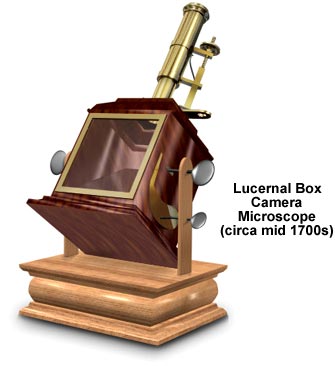Lucernal Box Camera Microscope
Development of the lucernal projection microscope in the late eighteenth century followed a long progression of solar microscopes. Unlike solar microscopes, the lucernal microscope depended upon an oil lamp for illumination rather than the sun. An original version of the microscope was photographed and described by Gerard Turner in his excellent volume Collecting Microscopes.

The microscope illustrated above was described by Ledermüller in 1762 in his book Nachleese seiner Mikroskopischen Gemüthe-und Augen-Ergötzung. Basic construction consists of a rectangular box having an inclined mirror positioned in the center and a microscope body tube at the top. A plate of glass on one side of the box allows viewing and positioning of the specimen. Thumbscrews on the microscope base enable the microscopist to rotate the box with respect to the oil lamp to maximize illumination. Focus is achieved using a worm gear that moves the microscope body up and down above the light exit port of the rectangular box.
BACK TO EIGHTEENTH CENTURY MICROSCOPES
